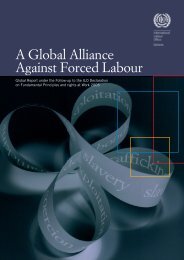equal by law, unequal by caste - International Dalit Solidarity Network
equal by law, unequal by caste - International Dalit Solidarity Network
equal by law, unequal by caste - International Dalit Solidarity Network
Create successful ePaper yourself
Turn your PDF publications into a flip-book with our unique Google optimized e-Paper software.
288 Wisconsin <strong>International</strong> Law Journalinternational human rights <strong>law</strong>. 177 Chief among these fundamental rightsis the right to <strong>equal</strong>ity. Article 14 of the Constitution of India reads:“The state shall not deny to any person <strong>equal</strong>ity before the <strong>law</strong> or the<strong>equal</strong> protection of the <strong>law</strong>s within the territory of India.” 178 Anexception clause allows for affirmative action measures under somecircumstances. “Nothing in this article . . . shall prevent the state frommaking any special provision for the advancement of the socially andeducationally backward classes of citizens or for the Scheduled Castesand Scheduled Tribes.” 179The clause marks a significant departure from the Americanmodel on which India’s <strong>equal</strong>ity provision is based and constitutionalizesthe validity of affirmative action in the Indian context. The Indian modelis also one of substantive <strong>equal</strong>ity. If formal <strong>equal</strong>ity aims at <strong>equal</strong>opportunity, then substantive <strong>equal</strong>ity aims at <strong>equal</strong> results <strong>by</strong>considering the social structures in which <strong>equal</strong> results would notnecessarily result from formal <strong>equal</strong>ity guarantees.The Court has interpreted Article 14 on a number of occasions ascharging the state with ensuring that there is <strong>equal</strong>ity among <strong>equal</strong>s. 180 InState of Kerala v. Thomas, the Supreme Court noted that,The guarantee of <strong>equal</strong>ity before the <strong>law</strong> or the <strong>equal</strong> opportunity inmatters of employment is a guarantee of something more than what isrequired <strong>by</strong> formal <strong>equal</strong>ity. It implies differential treatment ofpersons who are un<strong>equal</strong>. . . . Formal <strong>equal</strong>ity is achieved <strong>by</strong> treating177 See generally MARC GALANTER, COMPETING EQUALITIES: LAW AND THE BACKWARD CLASSESIN INDIA (1984) (analyzing treatment of <strong>Dalit</strong>s under Indian Constitution).178 INDIA CONST. art. 14. Article 14 thus marries the English doctrine of the “Rule of <strong>law</strong>” with the<strong>equal</strong> protection of clause of the Fourteenth Amendment to the U.S. Constitution. BashesharNath v. CIT, (1959) Supp. 1 S.C.R 528, 551 (Per Das C.J). In the U.S. Constitution, thelanguage of the Fourteenth Amendment reads, “No state shall . . . deny to any person within itsjurisdiction the <strong>equal</strong> protection of the <strong>law</strong>s.”179 The “schedule” of <strong>caste</strong>s in India was originally created <strong>by</strong> the British in 1936, using the censusdata of the same year and “an ad hoc mixture of social, religious, economic, educational andeven residential considerations.” Christopher Ford, Administering Identity: The Determination of“Race” in Race-Conscious Law, 82 CAL. L. REV. 1231, 1269 (1994); Priya Sridharan,Representations of Disadvantage: Evolving Definitions of Disadvantage in India’s ReservationPolicy and United States’ Affirmative Action Policy, 6 ASIAN L.J. 99, 109 (1999). While this listdid not accurately reflect <strong>caste</strong> membership and group interrelations, the post-independencegovernment adopted the list as its own after incorporating some amendments. Id. at 110 (notingas significant the addition of Sikh “untouchables” to the list). The list of scheduled <strong>caste</strong>s mayonly be modified <strong>by</strong> a full Act of Parliament involving “rather elaborate procedures,” and takinginto account multiple factors such as <strong>caste</strong> membership and economic data. Ford, supra 179, at1269; Dudley Jenkins, supra note 31, at 758.180 See State of Kerala v. Thomas, (1976) 1 S.C.R. 805 (“Those who are similarly circumstanced areentitled to <strong>equal</strong> treatment.”); Madhya Pradesh Ration Vikreta Sangh Society v. State of MadhyaPradesh, (1982) 1 S.C.R. 750.
















